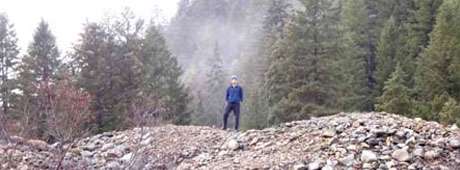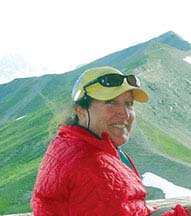No products in the cart.
Murray–Spotlight

Still As Good As Gold
By Mary Terra-Berns
In the mid-1990s, I worked for the Idaho Department of Fish and Game (IDFG) conducting goshawk nest surveys in the forests of northern Idaho.
My predecessors had surveyed all the stands close to roads and trails, leaving me to hike across ridgetops and steep slopes, cross streams, and beat my way through brush and thick timber in pursuit of those beautiful birds. Occasionally, I would stumble upon old mine shafts. Some were open and some had a bat gate across the entrance, but around practically all of them was scattered rusting pipe, equipment, or machinery. Such discoveries always made the day interesting, especially when I got goose-egged by the goshawks. At the end of the day, if I returned to my truck in time, I would head to Murray for an old-fashioned milkshake at the Sprag Pole Tavern. After a long hot day of hiking, for me a shake was as good as gold.
Murray occupies a wide, flat spot between Prichard Creek and Murray Peak about six miles up Prichard Creek Road from its junction with Coeur d’Alene River Road. Back in the 1800s, Prichard Creek and its tributary, Eagle Creek, were El Dorado for many hopeful prospectors stampeding to northern Idaho. In just a few years, this narrow drainage that used to be off the beaten path produced millions of dollars in gold.
George Murray was one of those hopeful prospectors. He was a part owner of one of three claims on which his namesake town was built. Originally named Curry by the two surveyors who laid out the town, it became Murrayville as a jumble of tents, shacks and rough cabins materialized where very dense woods once stood. The name was shortened to Murray in 1885 when the boomtown became the seat of Shoshone County. George Murray faded into obscurity but the town became a golden hot spot in the late 1800s for thousands of fortune-seeking hopefuls.
Before all those people arrived, northern Idaho was considered an almost impenetrable wilderness. In 1842, when Jesuit priest and missionary Pierre Jean De Smet traveled from the Mission of the Sacred Heart, now within Old Mission State Park near Cataldo, to the Mission of St. Ignatius in Montana, he described the Coeur d’Alene Mountains as “untrodden forests strewn with thousands of trees thrown down by age and storm.” Amen to that, Father.
This content is available for purchase. Please select from available options.
Purchase Only
Purchase Only

